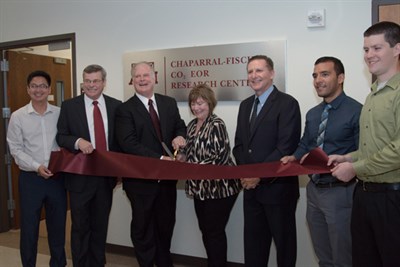 Texas A&M University’s Harold Vance Department of Petroleum Engineering held a ribbon cutting ceremony Tuesday, October 7 for the newly established Chaparral-Fischer CO2 Enhanced Oil Recovery Center. The lab was established with a $1.75 million donation from Chaparral Energy and SuSu and Mark Fischer (’72) to the Texas A&M Foundation.
Texas A&M University’s Harold Vance Department of Petroleum Engineering held a ribbon cutting ceremony Tuesday, October 7 for the newly established Chaparral-Fischer CO2 Enhanced Oil Recovery Center. The lab was established with a $1.75 million donation from Chaparral Energy and SuSu and Mark Fischer (’72) to the Texas A&M Foundation.
Fischer is chief executive officer and chairman of the board of Chaparral Energy in Oklahoma City, Oklahoma. Chaparral Energy is the third-largest operator in the United States for CO2 enhanced oil recovery based on the number of active projects. The Chaparral-Fischer CO2 Enhanced Oil Recovery Center, overseen by principal investigator Dr. David Schechter, associate professor and Aghorn Energy Career Development Professor, will be used to study and improve the use of carbon dioxide as an enhanced oil recovery agent in both conventional and unconventional reservoirs.
Injecting carbon dioxide into an oil reservoir frees up trapped oil by lowering its viscosity to improve flow rate, enhancing and extending the production life of an oilfield. Most of the carbon dioxide used for injection occurs naturally, but some energy companies, such as Chaparral Energy, are using manmade carbon dioxide captured from emissions produced by industrial plants in various industries. Rather than being released into the atmosphere, the carbon dioxide is captured and then routed via pipeline to oilfields and then injected into oil producing reservoirs.
The donation from Chaparral and the Fischers will also support several graduate students in petroleum engineering who will be helping researchers investigate the potential to increase oil recovery and the identification of the recovery mechanisms and their impact in unconventional reservoirs. In conventional reservoirs, researchers will focus on understanding the sweep efficiency issues related to CO2 flooding in heterogeneous and fractured rocks. They also will look into continuous CO2 injection, water-alternating-gas (WAG), chemically aided WAG, direct CO2 thickening and the use of nanoparticles.
“We are honored to help cultivate the next generation of industry leaders with support of the Chaparral-Fischer CO2 lab at Texas A&M University,” said Fischer. “It is this continuous pursuit for improvement that not only propels Chaparral, but our industry as a whole. By providing tools and resources such as this, we hope to fuel innovation for decades to come.”
“We deeply appreciate the generosity of this gift from Chaparral and the Fischers,” said Dr. M. Katherine Banks, vice chancellor and dean of engineering. “By forming partnerships with industry leaders such as Chaparral, we are able to enhance our students’ educational experiences by giving them opportunities to work on real-world engineering challenges here at Texas A&M.”
The Fischers have been longtime supporters of both academics and athletics at Texas A&M, and recently contributed $12 million to the construction of the university’s Engineering Education Complex, in support of Texas A&M’ Engineering’s 25 by 25 initiative.